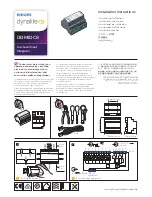
Overview
Installation
Troubleshooting
Contact
FAQ
Specifications Glossary
License
Configuration:
Basic Gateway TCP/IP Wireless USB
SBG940 User Guide
114
Glossary
This glossary defines terms and lists acronyms used with the SBG940.
A
access point
A device that provides WLAN connectivity to wireless clients (stations). The SBG940 acts as a
wireless access point.
adapter
A device or card that connects a computer, printer, or other peripheral device to the network or to
some other device. A
wireless adapter
connects a computer to the WLAN.
address
translation
See
NAT
.
ALG
Application level gateway triggers are required by some file transfer (for example, FTP), game, and
video conferencing applications to open one or more ports to enable the application to operate
properly.
American Wire
Gauge (AWG)
A standard system used to designate the size of electrical conductors; gauge numbers are inverse to
size.
ANSI
The American National Standards Institute is a non-profit, independent organization supported by
trade organizations, industry, and professional societies for standards development in the United
States. This organization defined ASCII and represents the United States to the International
Organization for Standardization.
ANX
Automotive Network Exchange
ARP
Address Resolution Protocol broadcasts a datagram to obtain a response containing a MAC address
corresponding to the host IP address. When it is first connected to the network, a client sends an ARP
message. The SBG940 responds with a message containing its MAC address. Subsequently, data
sent by the computer uses the SBG940 MAC address as its destination.
ASCII
The American Standard Code for Information Interchange refers to alphanumeric data for processing
and communication compatibility among various devices; normally used for asynchronous
transmission.
asynchronous
timing
The SBG940 uses synchronous timing for upstream data transmissions. The CMTS broadcasts
messages that bandwidth is available. The SBG940 reserves data bytes requiring x-number of
mini-slots. The CMTS replies that it can receive data at a specified time (synchronized). At the
specified time, the SBG940 transmits the x-number of data bytes.
attenuation
The difference between transmitted and received power resulting from loss through equipment,
transmission lines, or other devices; usually expressed in decibels.
authentication
A process where the CMTS verifies that access is authorized, using a password, trusted IP address,
or serial number.
authorization
Part of the process between a CMTS and the cable modem or gateway to enable Baseline Privacy.
auto-MDIX
Automatic medium-dependent interface crossover detects and corrects cabling errors by automatically
reversing the send and receive pins on any port. It enables the use of straight-through wiring between
the SBG940 Ethernet port and any computer, printer, or hub.
















































